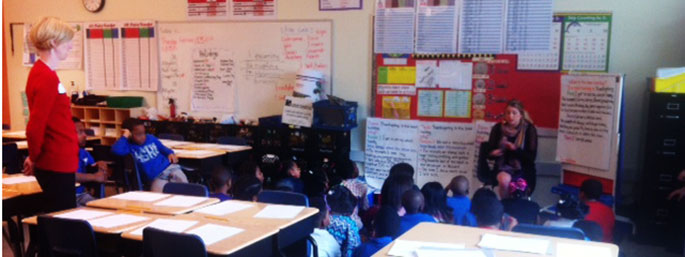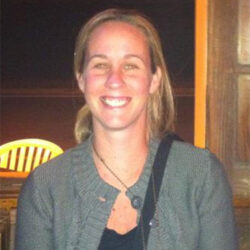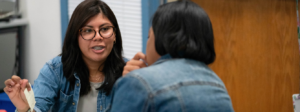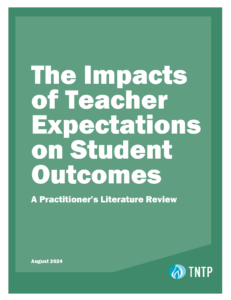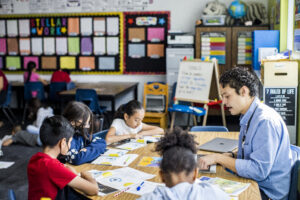If teachers are like rock stars—and we definitely think they are—they are accustomed to being alone on the stage, commanding authority as they thrill their audiences. But sometimes, with the right sales pitch, they will follow in P!nk and Rihanna’s footsteps and try a duet.
That’s our coaching approach at the TNTP Teaching Fellows program here in New Orleans. In the past, instructional coaches like us stood in the back of the classroom and observed, or watched a video, or heard second-hand about how a performance went awry. It was a passive approach that prevented us from helping teachers correct their mistakes in the moment, before learning time was lost.
So we’ve stepped into a more active, hands-on coaching role, using a strategy that we call—wait for it—“Sing a Duet.” Instead of watching and then offering feedback after the fact, we jump in to temporarily lead a class when a new teacher needs to see a critical technique done right, right away—and then spend our time together afterwards practicing until it’s perfect. Here’s how it works.
Tieal on Coaching Ronnie:
Ronnie teaches fifth and sixth grade social studies. At the start of the year, his instruction was well planned, but his students weren’t buying it. When Ronnie would give loosely delivered directions like “Come on, guys, listen,” the students would ignore him and carry on with their individual conversations.
As his coach, when I see this, I know that it’s time to jump in and show Ronnie exactly what clear directions sound like. So, when this happened during class recently, I looked at Ronnie and pointed to myself (our pre-planned signal to let him know it’s my turn to model). “Class, I need all eyes on me,” I said. “Voices off and hands folded on your desk, just like Marcus and Cassie.” All was quiet.
After class, I asked Ronnie to reflect on the difference between his directions and mine, and he correctly noted that mine were clear, concrete, sequential and observable (known as “What to Do” directions in Doug Lemov’s Teach Like a Champion). Because I had actually used the technique in front of him with real students, Ronnie could see exactly how it worked—and how he could put it to use the very next day.
But first, we had to practice, to make sure he could actually execute the technique. So in an empty classroom, I pretended to be his student while Ronnie stood in the front of the room, repeating those same three directions over and over again. I offered feedback, and each time, he got a little stronger. Finally, he spoke clearly and calmly, in a tone that left no room for students to question exactly what was expected of them. He seemed ready to do it live.
But when I came back to his class the next day, he was still not consistently giving the directions we had practiced. It was time to work as tag-team teachers—so at the back of the room, I pulled out a small whiteboard and wrote reminders to cue him: ALL EYES ON ME. VOICE LEVEL 0. HANDS ON YOUR DESK.
Ronnie read my cues, repeated the directions as we had practiced—and his students began to follow them. He’d seen it, and he’s practiced it. By then, all he needed was a reminder in the moment, and the lesson was back on track.
Meredith on Coaching Rachel:
Rachel teaches guided reading instruction. During a recent visit, Rachel read aloud to a group of students, as they pointed to the words in their own books, learning to track word-to-word. One student was struggling, but Rachel didn’t seem to notice. His motor skills weren’t great—his hand was splayed across the page, and he couldn’t keep up with her pace. It was time to jump in.
I made eye contact with Rachel to let her know I was stepping in, and then told the student, “To point word-to-word, we need to make a pointer finger. Point this finger and curl up your other fingers into your palm.” Then I put my hand over the student’s hand, to help him point as Rachel read. She was still going too fast, so I piped in to read along and slow her down, so she could hear the best pace for this group.
Rachel picked up on my cues and started to match my pace. As she turned the next page, she reminded the boy to keep pointer out and his other fingers curled up. Reading instruction—and teacher development—was happening!
Not every active coaching experience goes off so smoothly. Without a trusting relationship between teacher and coach, a confident coach willing to jump in and a teacher willing to let them, active coaching won’t work. It’s especially vital to make sure that our teachers know that we are there to support, not just challenge them. That means little things, like giving teachers our cellphone numbers, texting messages of support and being at the ready to answer questions whenever they arise.
Some may wonder if we aren’t helping teachers too much—after all, shouldn’t they have to figure it out for themselves? That’s an approach that most training programs take, and it’s one we have ended. We think it’s critical to give teachers the precise skills they need to teach effectively, right away—like making sure a pianist has mastered her scales so she can quickly advance to a complex melody.
It’s a model that demands a great deal from both the teacher and the coach. But the rewards onstage and off are well worth it—and by fixing problems in the moment, rather than waiting to debrief after class, students are learning more too.
